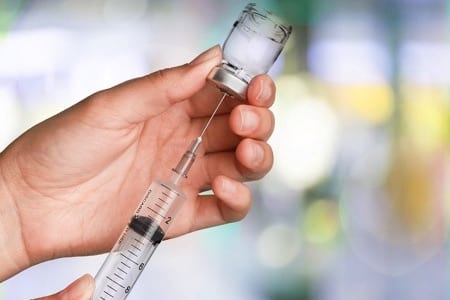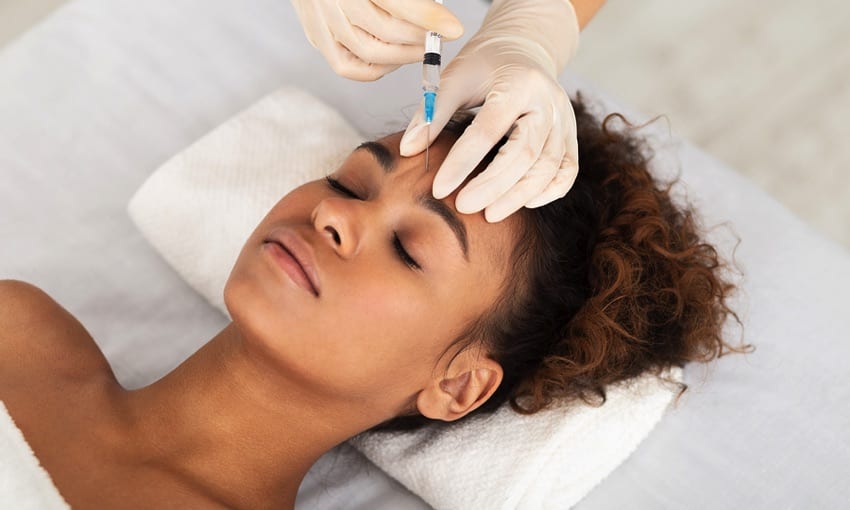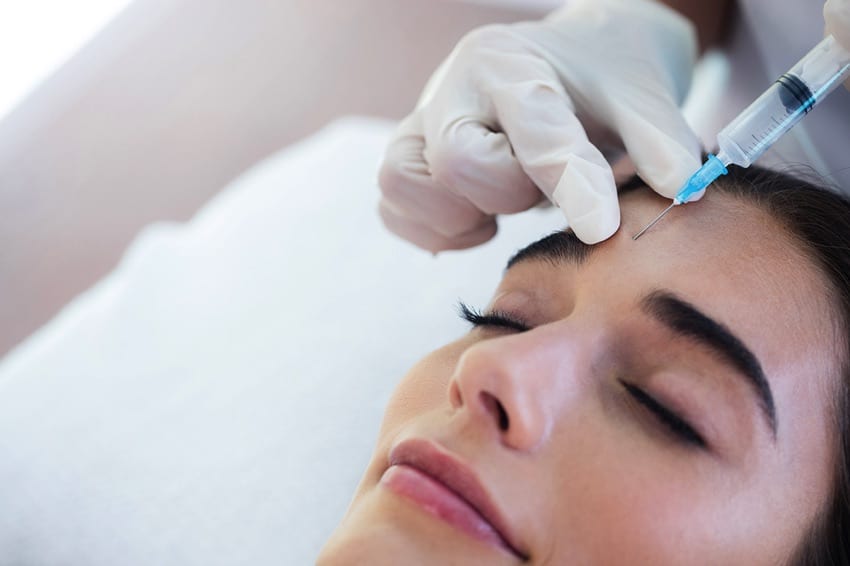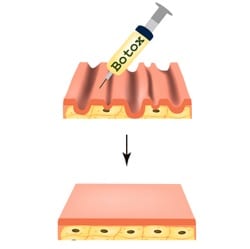 If you are reading this we assume you know what Botox is, at least in general terms, but if not, as a verb it essentially involves injecting a bacteria-based toxin (Botox in noun form) into your face.
If you are reading this we assume you know what Botox is, at least in general terms, but if not, as a verb it essentially involves injecting a bacteria-based toxin (Botox in noun form) into your face.
Where do I sign up, we hear you cry? Leaving aside concerns about whether having Botox is a good, wise, safe or sensible thing to do, for many, the only important question will be: is Botox vegan?
What Is Botox?
Well, Botox is short for botulinum toxin, a neurotoxin produced by a specific strain of bacteria, Clostridium botulinum. Botox is actually a trade name and is one of a number of products made by Irish-based (for tax purposes – they make most of their money in the US) pharmaceutical company Allergan.
Botox is produced without the use of animal products or processes and so many would view it as vegan. Bacteria, though living, are not part of the animal Kingdom and whilst they used to be classed as plants, they are now considered to be single-celled prokaryotes. There is no need to get too scientific at this juncture: Botox is not made from animals and its production does not harm, exploit or utilise animals in any way (other than if your companion animal no longer recognises you with your smooth, wrinkle-free skin and slightly startled look).
So, Botox is vegan right? Well, there is one rather huge reason why many do not consider Botox to be suitable for vegans and that is animal testing.
Is Botox Tested on Animals?

Whilst many think of Botox purely for its role in the Sisyphean battle against Father Time, it is in fact a medical product with a whole range of uses (see below). As we discuss in our article on vegan vaccinations and medicine, virtually all such items are required by law to be tested on animals before they can enter the market.
Whilst Allergan, who make Botox, are committed to reducing and minimising animal testing (see their reply to our email below), the fact is that Botox has been tested on animals. In the case of vaccines it is our belief, and that of most vegans, that the benefits to society and health far outweigh the negatives of the necessary testing on animals. This, we would argue, most definitely falls under the “as far as is possible and practicable” clause that lies within the Vegan Society’s definition of veganism.
The same applies to just about every other medicine and medical product out there and, as we have stated elsewhere, a dead vegan is no good to anyone. You cannot save the lives of animals, stop cruelty and encourage others to become vegan if you have died because you hadn’t followed medical advice.
Of course, there is a very big difference between vaccinating your new born child against deadly and preventable diseases and viruses, and injecting your face with Botox to look a bit younger. That said, when it comes to approved medical products, the animal testing is in the past. Whilst some vegans try to eschew as far as possible any company that has ever carried out tests involving animals, others are happy to accept that historical testing that was necessary on medical grounds does not render such items non-vegan.
For example, some vegans try to use painkillers, such as paracetamol, only when absolutely necessary. Others acknowledge that by using such medicine they are in no way causing any further harm or suffering to animals and so are happy to go ahead.
When it comes to Botox, in the US it received approval from the Food and Drug Administration in 1989. That is now more than 30 years ago. Moreover, it was initially used solely for ocular dystonias (also called blepharospasms, these are painful spasms or contractions of muscles around the eye) and so whatever animal testing carried out was done a long time ago with the aim of medical, rather than cosmetic, usage.
As with much when it comes to veganism, in many ways you must make a personal choice on this. Lots of vegans are happy to have Botox, whilst others feel using an unnecessary (assuming you are using it for cosmetic purposes) animal-tested product goes against their beliefs. As ever, we are here to inform, not judge or preach!
What About Eggs?
What about eggs indeed? Well, earlier we stated that Botox was produced in an entirely vegan fashion but there are many sources that claim eggs, or more accurately the albumen from eggs, is used in the production process.
Renowned medical source (just to be absolutely clear, this is sarcasm!) Glamour Magazine states that,
Another lesser known consideration regarding Botox is that it is prepared using an egg base. Yep. In fact, doctors are warned to never administer Botox to anyone with an egg allergy as it could trigger an allergic reaction.
This is a “fact” repeated at many sites but, thankfully, for vegan Botox fans it appears to be fake news. A little more digging suggests that Botox is not made using egg albumen. The hopefully-more-reliable Healio, a compiler of medical news and updates for industry professionals, explains that actually human albumen is used.
They claim that, “patients with egg allergies may have an increased likelihood of an allergic reaction since the Botox molecule is stabilized by human albumin, a protein that is similar to egg albumen”. Those are the words of Dr William Lipham, MD, FACS (we have NO idea what those letters mean but they’re pretty impressive, right?), an expert Minnesota ophthalmology specialist who is very well versed in using Botox medically. Moreover, Allergan have previously said that there is only a very low chance of cross-reaction with someone allergic to eggs being allergic to Botox.
All that said, as impressive as Dr Lipham’s post-name letters are, we’re professionals here at Vegan Friendly, so we’ve asked Allergan, who make Botox, directly:
Allergan Confirm Botox is Vegan
Good news, vegan Botox fans – Allergan have confirmed that Botox is indeed vegan! We asked them about the issue of eggs and albumin and they stated the following:
We can confirm that the Summary of Product Characteristics (SPC) for Botox lists the following ingredients:
-
- Botulinum toxin type A from Clostridium botulinum
- Human albumin
- Sodium chloride
What’s more, they went on to clarify their position with regards Botox and ongoing animal testing, saying that:
Allergan obtained FDA approval in June 2011 for an in vitro, cell-based assay (non-animal) for product release testing of BOTOX and BOTOX Cosmetic.
What is Botox Used For?

As said, Botox has applications for those with muscular spasms and is well known for its ability to reduce and prevent wrinkles. However, it also has a very wide range of further medical uses. The official Botox site lists the following:
- Pediatric (sic) upper limb spasticity
- Chronic migraine treatment
- Overactive bladder problems (neurologically caused and otherwise)
- Eye muscle alignment
- Excessive sweating, especially under the arm
- Adult focal spasticity (leg or arm stiffness)
- Cervical dystonia (neck alignment and stiffness problems)
It has also been linked to treatment for depression, with some small trials suggesting it may help, although this is not yet a licensed use. There are also Phase II development trials for its use in treating a further wide range of medical issues, including premature ejaculation, labial herpes (all the good stuff), carpal tunnel syndrome, gastrointestinal problems and more.
As and when Botox was prescribed or suggested for such problems, that would be at the advice and recommendation of a doctor or other medical professional. What’s more, any procedure would be carried out by a similarly qualified person. But does using Botox for cosmetic purposes come with these same assurances?
Is Botox Safe?
Allergan reported sales of more than $3bn for Botox in 2017 and that continues to grow. That’s almost enough Botox to keep the foreheads of Simon Cowell and fellow Britain’s Got Talent co-host, Amanda Holden, crinkle-free. It’s a lot of Botox and a large proportion of it is used to smooth wrinkles and make people look younger.
Botox has been used for a long time and by and large is safe – it is fully licensed and regulated, after all, and there have been very few reports of serious adverse reactions, even when it is used cosmetically. However, new research is being undertaken all the time and in 2016 a study suggested that the toxin may be able to move about the body, rather than staying where it was injected.
This wasn’t exactly a ground-breaking discovery, as the US Food and Drug Administration (FDA) issuing a similar warning in 2009. However, it now seems there is real evidence to support this and that could lead to complications with other parts of the nervous system. However, one of the scientists involved in the research, Edwin Chapman, did add, “all toxins have a limited life. For most patients, regardless of how Botox is used, it will eventually be destroyed by the body.”
Indeed, it is true that Botox does have an excellent record in terms of safety. This is a view backed up by the NHS, who say, “The risks of Botox injections are small if it’s done correctly by a suitably qualified practitioner.”
Botox is not available on the NHS but they do give a good amount of advice on how to choose a practitioner if you do want to go ahead. Whilst they state that, “Very rarely, serious problems such as blurred or double vision can happen if the area around the eyes is treated, or breathing difficulties if the neck area is injected,” all in all, we have to agree that Botox is safe.
Botox: Conclusion
 Ignoring safety issues and the rights and wrongs of cosmetic procedures, Botox is probably fine for most vegans. Makers Allergan have in the past, and continue to, carried out animal testing but are committed to reducing that.
Ignoring safety issues and the rights and wrongs of cosmetic procedures, Botox is probably fine for most vegans. Makers Allergan have in the past, and continue to, carried out animal testing but are committed to reducing that.
In terms of Botox, said testing was carried out for medical reasons a long time ago. As such, given Botox is not made from animal products, nor uses, harms or exploits animals in its production, vegans can inject toxins into their faces with a largely clear conscience.